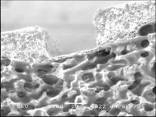I major in chemical engineering and technology. When I was a senior, I began to develop my graduate research work about the preparation and characterization for polymer ultrafiltration membrane。The polysulfone and NMP are used as the polymer and solvent separately. The plat-sheet ultrafiltration membrane had been prepared by phase inversion method, which is one of the most used and thus important techniques for the membrane formation. Moreover the pore size and size distribution had been characterized by Atomic force microscope, and Scanning electron microscope. The flux and rejection rate were also determined.
After graduated, I continue to take the master dissertation. My research work is mainly focused on the transport and membrane separation. I began to develop the research work for nanofiltration membrane based on the ultrafiltration membrane. The piperazine and 1,3-Benzenedicarbonyl Dichloride were used as the organic and inorganic solvent, and the interfacial polymerization method was used to prepare the nanofiltration membrane. After that, I use the prepared membrane to separate the salt and dyestuff from solution, and the ultraviolet spectrophotometer, gel-chromatogram and ionic chromatogram were used as the analysis instruments. As to the separation performance of nanofiltration membrane, the rejection rate for bivalent ions can arrive 90%, but for univalent ions, it can only arrive 30% nearly. Moreover, I had done some research work about the hollow fiber nanofiltration membrane. During my master dissertation, I have done some computer simulation about the prediction of thermodynamic phase equilibrium properties for polymer membrane formation system. The equilibrium phase diagram is still a good tool for controlling the morphology and interpreting the membrane structure. Knowledge of phase equilibria (binodal curve) enables one to change the conditions for the preparation of membrane such as the temperatures and compositions of casting solutions and of coagulation bath to obtain an optimum structure. Therefore, the binodal curves of polymer systems are very important in the process of membrane formation. However, there are only a few experimental data of liquid–liquid equilibrium (LLE) for ternary polymer membrane formation systems available in the open literatures, On the other hand, the models based on the thermodynamics principle, such as Flory–Huggins model, poly-NRTL model, and so on, however, are usually not applicable to describe accurately the nonideal behavior of complex systems due to certain assumptions and simplifications. So I begin to develop the research work about the prediction of binodal curve for PSF/DMAC/water system based on artificial neural network.
You are welcome to publish the comments on gas and liquid membrane separation technology from materials to industrial applications.
My Photo

Micro-structure

inorganic membrane

Computer Simulation
Book
- Carbon Molecular Sieve Membranes for Gas Separation
- Environment Monitoring and Management Ability Construction
- Optimization Method for System Synthesis
Membrane Group
|
|
| Membrane Technology |
| Welcome to Visit |
International link
Where there is a will there is a way----------Excellence Pursuit
Correspondent: Xuezhong He
Email: hxz.hexuezhong@gmail.com

No comments:
Post a Comment